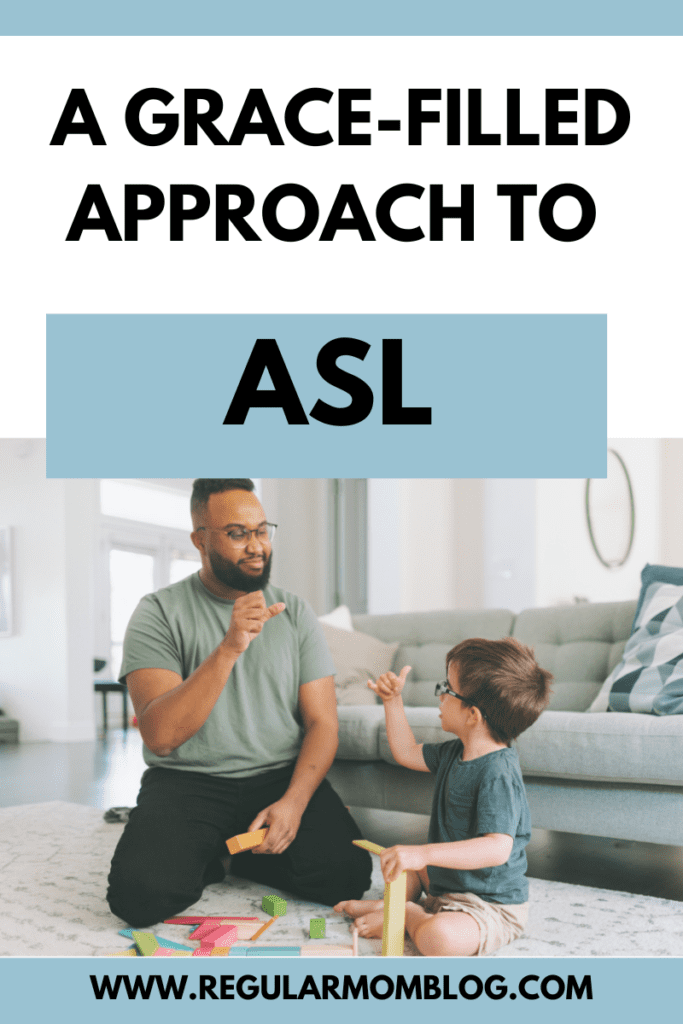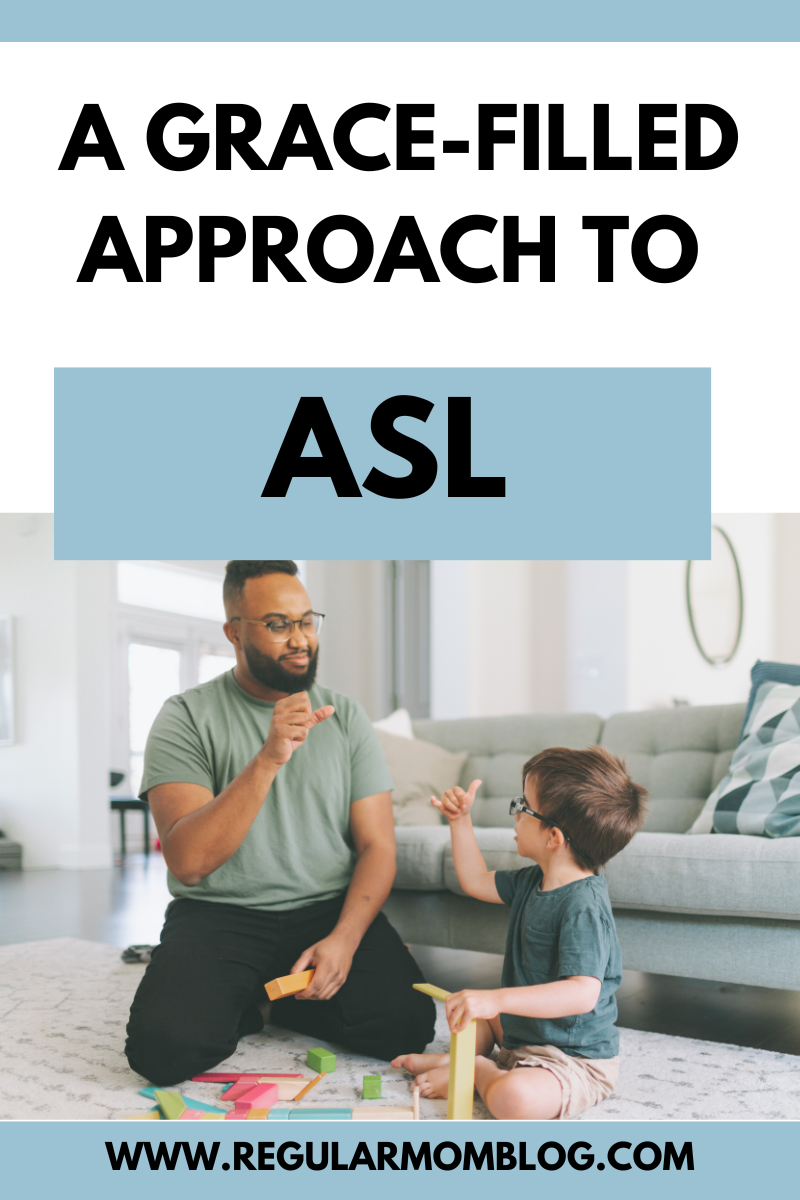advocacy
It’s time to get clear on a language strategy for your child so that you can consistently practice language in your home and watch your child’s communication soar in less time!
Welcome!
I want to show you how to build better language skills at home so you can also parent with clarity and confidence!
Categories
hearing loss
sensory activities
sign language
1:1 Language Coaching
These are the kinds of resources that you will find on my blog!
Happy reading!
Teach Children ASL- A Grace-Filled Approach
December 23, 2022
Teaching children ASL is a hot topic discussed in a lot of online groups for parents of kids with cochlear implants. Lately, I’ve noticed push back on parents who don’t choose to teach ASL to their children with cochlear implants and instead use only spoken language only in their house.
Many parents are even guilt- tripped by complete strangers for not teaching their children ASL!
Friends, it doesn’t have to be either/or in learning ASL There is a grace- filled way to embrace the choice of each parent to do what is best for their own child.
In this post we are going to discuss some benefits of teaching ASL to children with cochlear implants, and my best strategy to start using ASL signs with your child without feeling overwhelmed.

The benefits of children learning ASL
The use of ASL signs help a child’s understanding of overall language, and contribute to a “total communication” approach to language.
This is when a child receives language through both spoken speech and “visual speech” such as ASL.
A total communication approach benefits kids with cochlear implants.
By using both modes of communication it ensures that a child who wears cochlear implants can fully be a part of the conversation without missing out on parts due to hearing fatigue or noise in the background.
Hearing technology is still a relatively new invention. There is always more research being conducted on how to balance the hearing technology and the need for an additional visual aid depending on the hearing level of the child.
There are many benefits of ASL in children with cochlear implants, as the hearing technology evolves and our understanding of individual hearing loss also changes.

teaching children ASL Signs
When we had two children with hearing loss we often felt overwhelmed.
At the time, I couldn’t have conceived of teaching my children ASL on top of our already hectic life!
However, I committed to learning a few, important signs to bridge the gap for my oldest son to communicate while he learned to talk.
This approach worked well for us, and eventually my oldest son chose to mostly drop the signs and use spoken speec to communicate.
Our approach changed when my second son was born. He was born with a small cochlear nerve, and has moderate to severe hearing loss even with his cochlear implants.
As a result, his spoken speech is slow to develop.
Now, ASL signs are an integral part of his daily communication.
We are learning the full language of ASL and teaching our children.
We found for our family that learning the language of ASL best supports our son in fully communicating with us and his teachers.
Both of our boys have the same type of hearing loss, yet they experience that hearing loss in different ways.
In our family’s experience, every person has a unique experience with hearing. Because of this, a communication mode works for one family doesn’t necessarily work for another.
ASL in Social Media
There has been a big push on social media lately to increase the awareness of people in the deaf community who sign.
I’m personally thankful for the work that these accounts are doing to make ASL more mainstream and bring awareness to the deaf community.
However, many parents of kids with cochlear implants feel that the information out there often seems one- sided.
The message misses the mark in extending grace to the parents who are trying their best and can’t add more to their plates right now.
As our culture tends to do, we have found one side to support without allowing for the option for the other side to exist.
We have taken ASL signs and automatically applied it to every child with hearing loss, without considering the wishes of the entire family. Or even the need for ASL signs for the child’s communication.

Educate yourself about asl
I really like this quote from Laurent Clerc National Deaf Education Center because they acknowledge that the decision to choose a communication mode is not always easy. There is room to explore different modes of communication that work for the family and the child:
“Making choices about the best way to approach language and communication development for a child with a cochlear implant is not always clear. While the goal of obtaining a cochlear implant is to increase a child’s potential to access sound for the purpose of developing spoken language, it is important to keep this goal in perspective with all of a child’s needs and look at how sign language can be included. “
How do you know what is best for your family? In my opinion, it is to use spoken- speech and teach your child ASL signs, and then see which one your child prefers.
If your child is old enough to tell you how they prefer to communicate, I would honor their decision.
This was not the case with our boys as they were implanted at 11 months old before they could talk!
We provided both spoken speech and ASL signs at home. At some point, each child displayed an obvious preference for a communication mode.
You can use a “halfway” approach to asl signs
If you are curious about trying ASL out in your family, you don’t have to jump right in to learning the full language.
You can start with a few individual signs and incorporate different signs each week.
For our family, we find that a good entry point is to use spoken speech paired with an ASL sign.
When we felt capable and ready, my husband and I started to learn the full language of ASL to communicate better with our hard of hearing son.
A tool that helps me learn ASL is a free app on my phone called ASL Pocket Sign. It helps me learn signs quickly and include them in our daily routine with our kids.
There is no one-size fits all when it comes to determining how to communicate with your child with cochlear implants.
Spoken speech works for some families, while ASL and even cued speech and Signed Exact English work for other families.
Each family is unique and different. We should embrace the family and child’s right to choose their own communication mode.
Don’t forget to sign up to Teach Your Kids to Sign!
more resources for sign language
3 Practical Tips to Learn ASL Without Adding More to Your Day

tell me more!
tell me more!
@alemerinobranding.co
DESIGNED BY: ALE MERINO BRANDING CO.
COACHING
Navigation
PODCAST
ABOUT
HOME
Legal
PRIVACY POLICY
TERMS & CONDITIONS
Let's connect
EMAIL hello@raisingdeafkids.com
BLOG